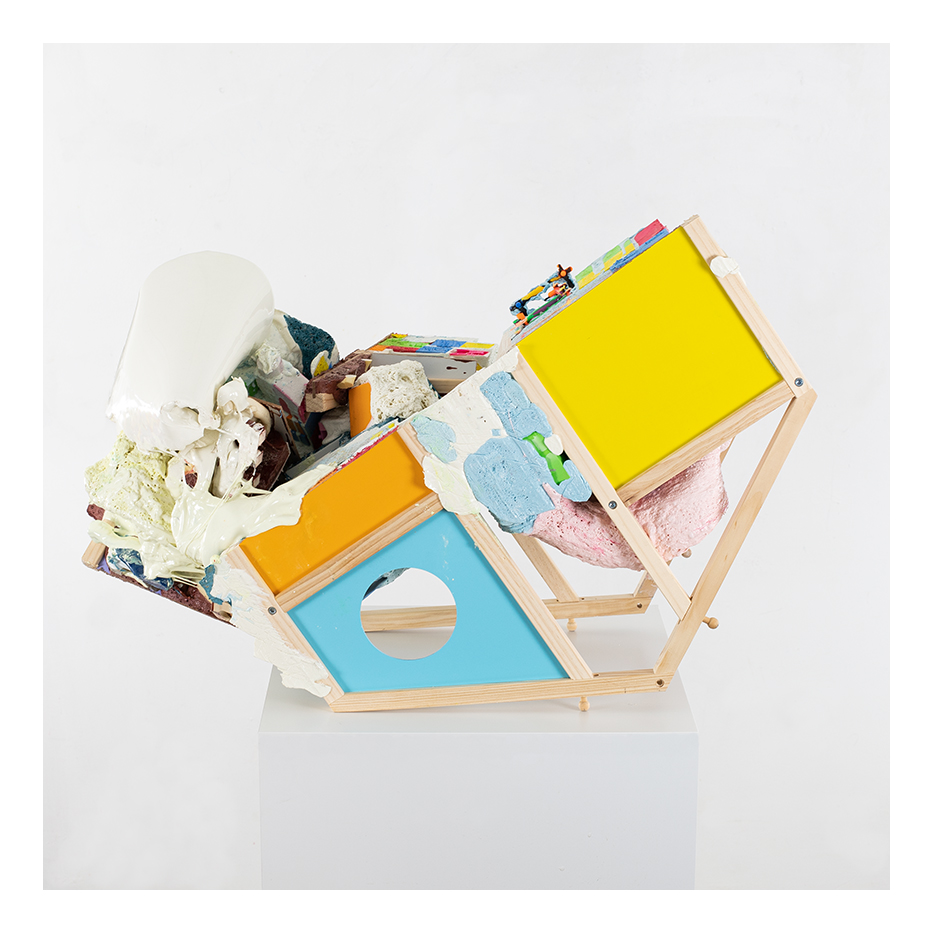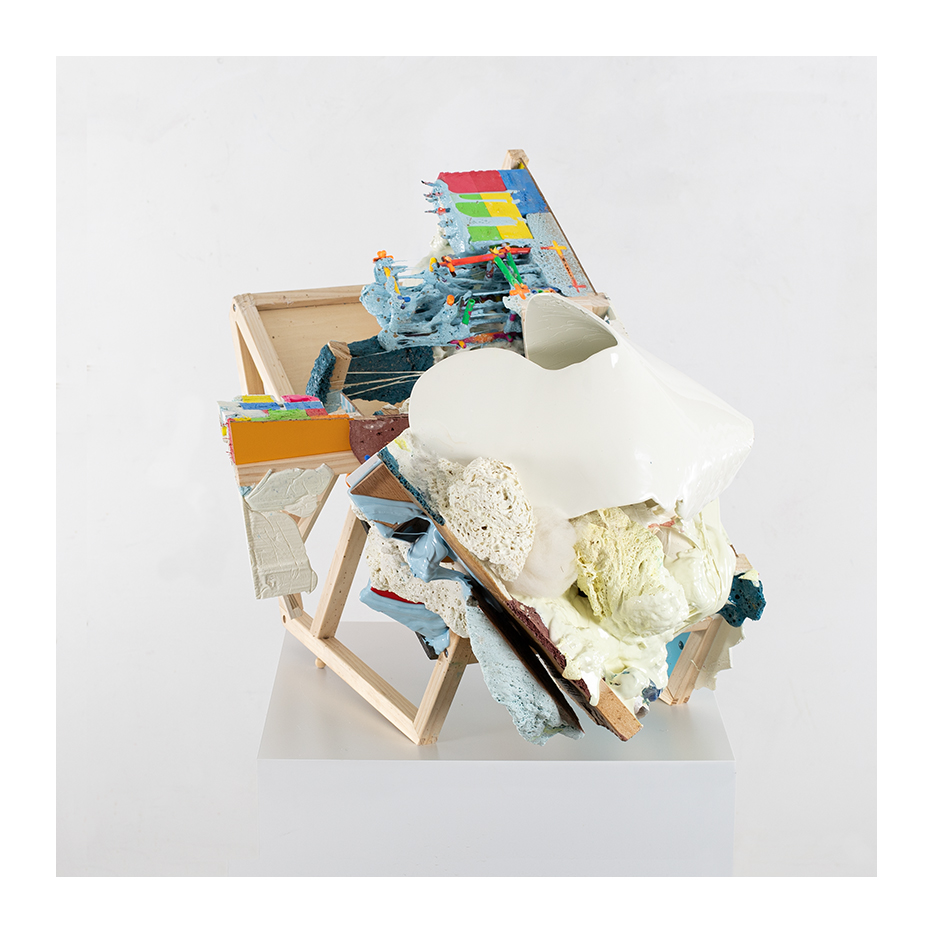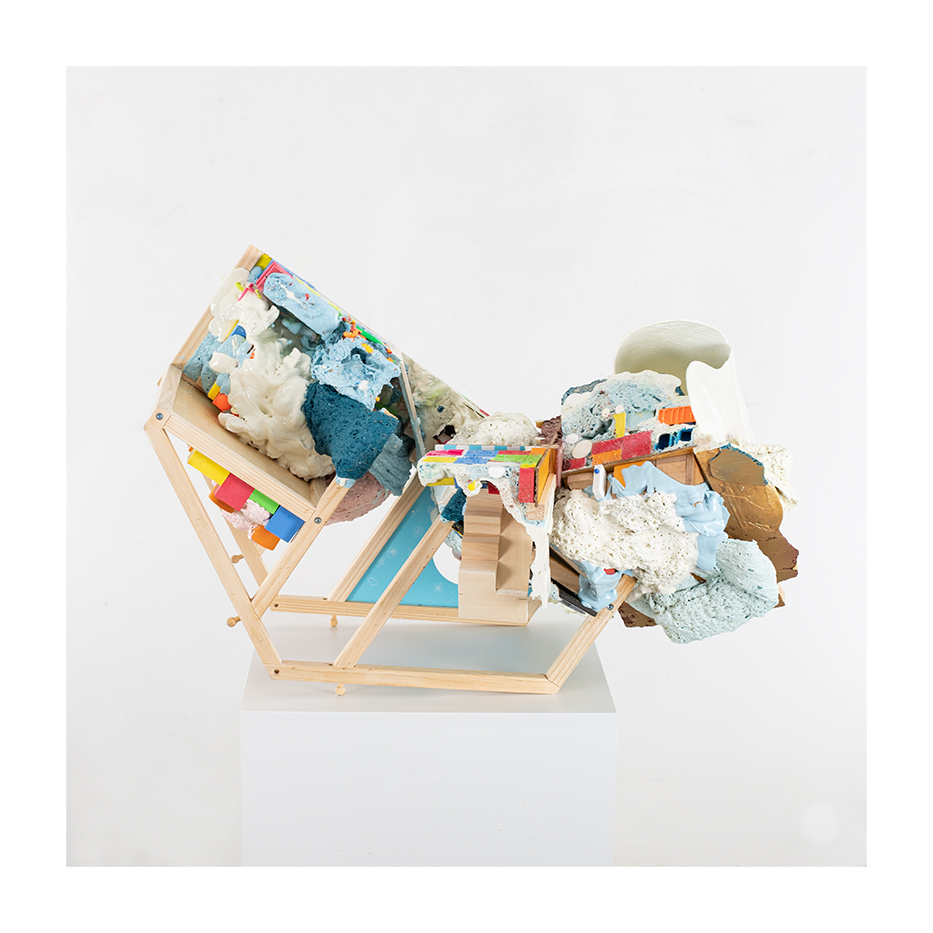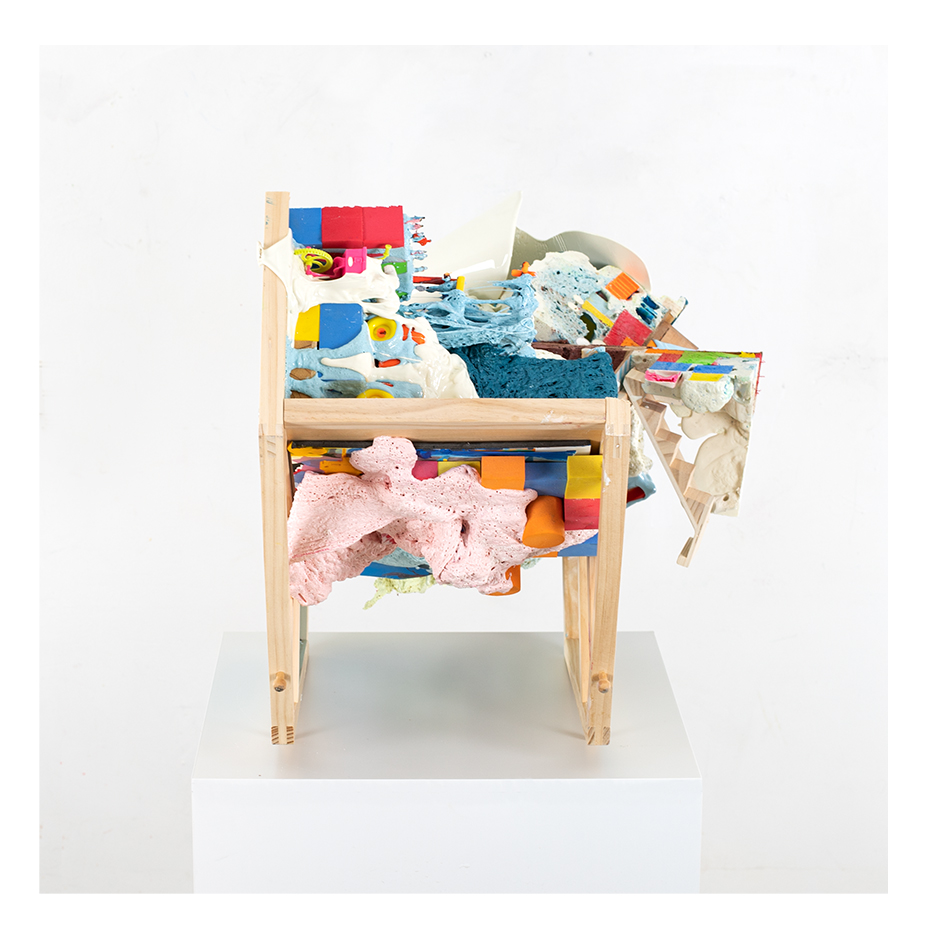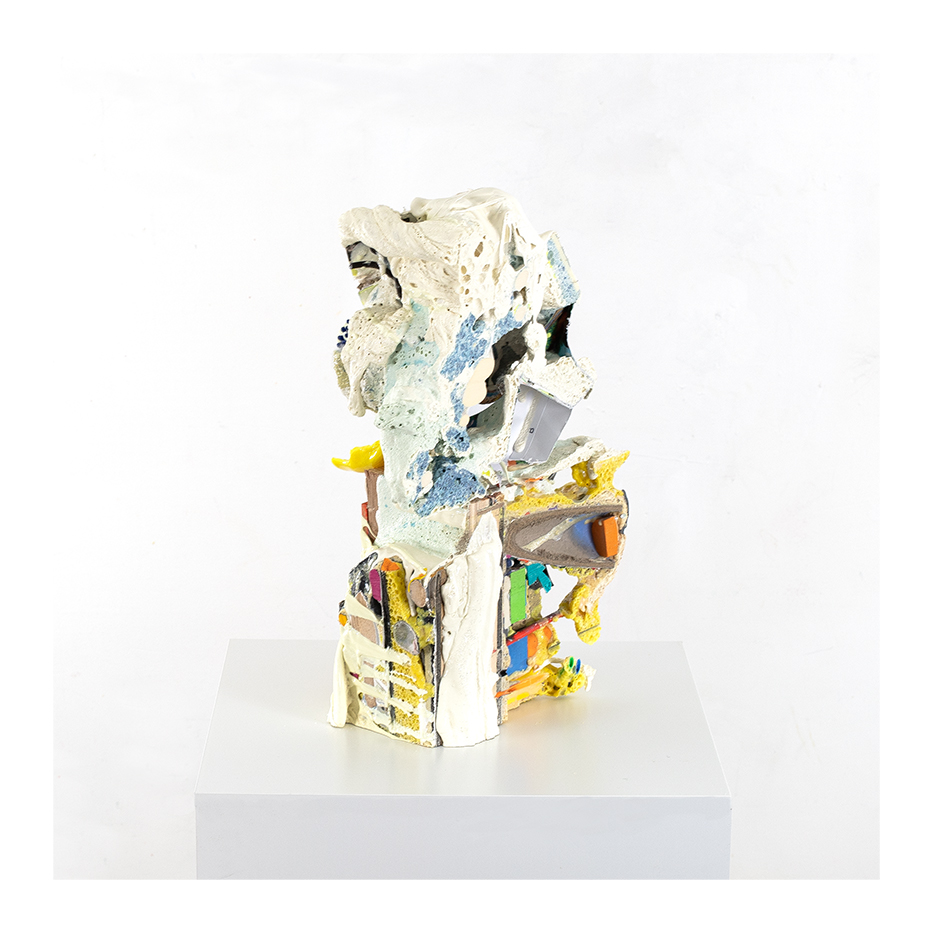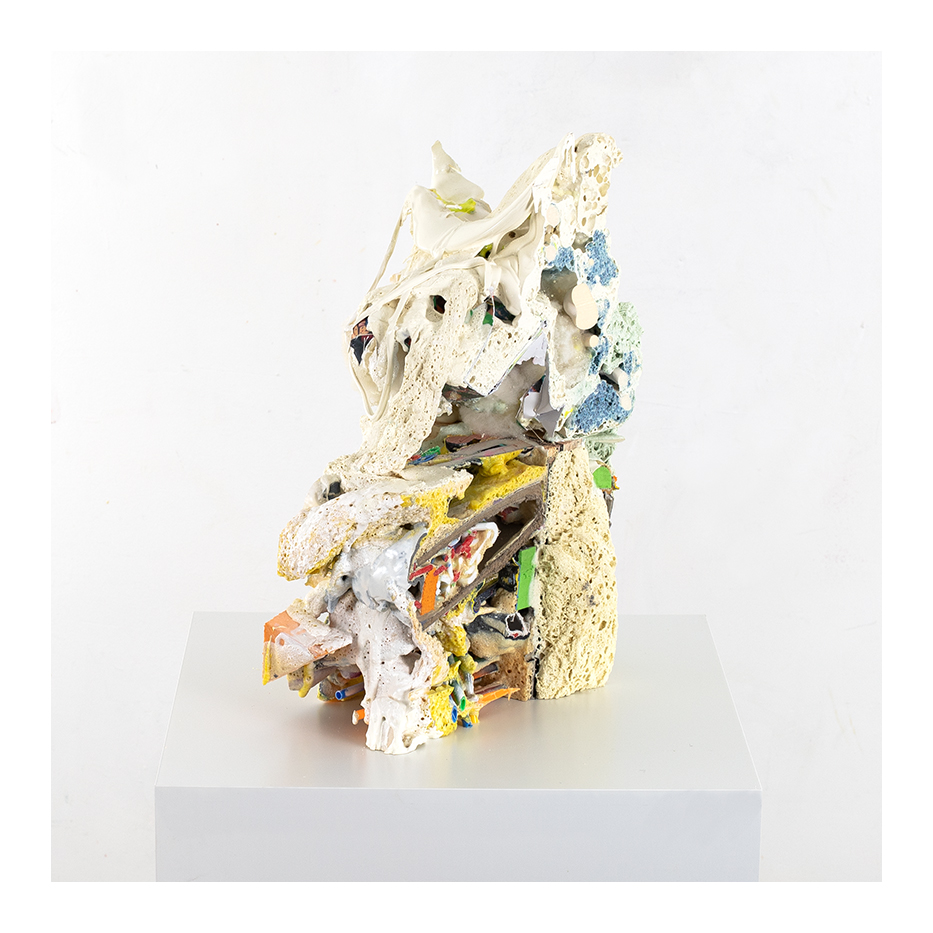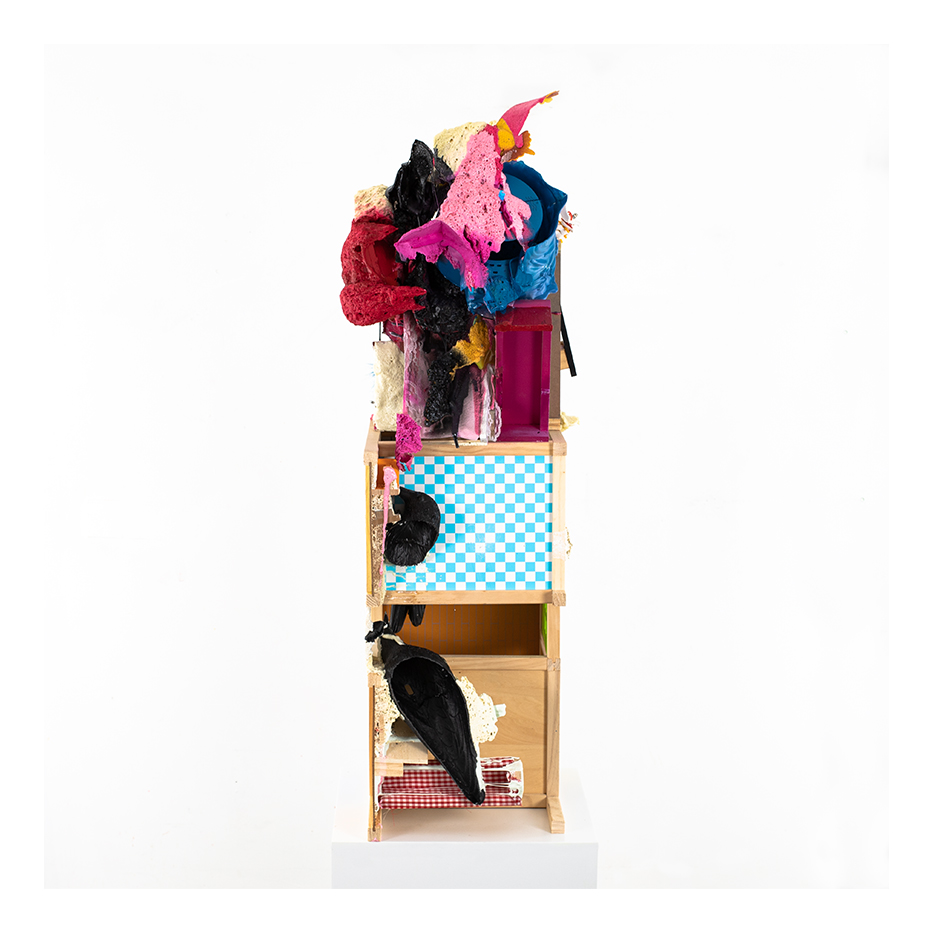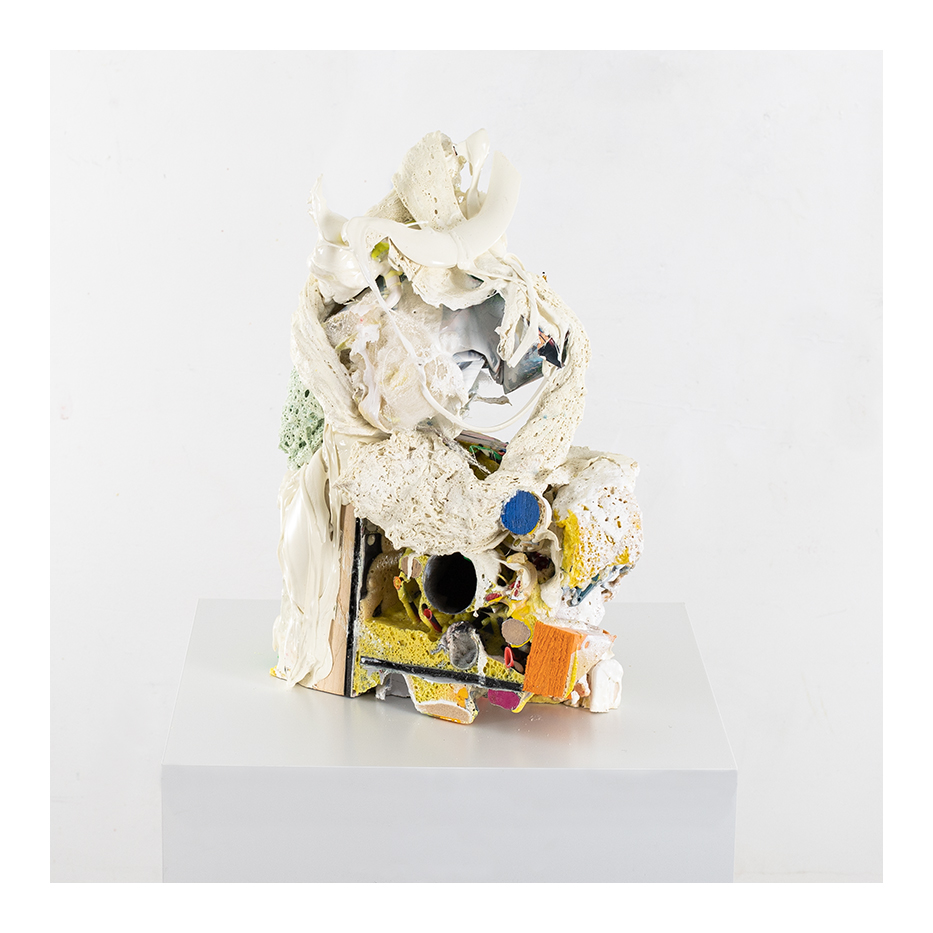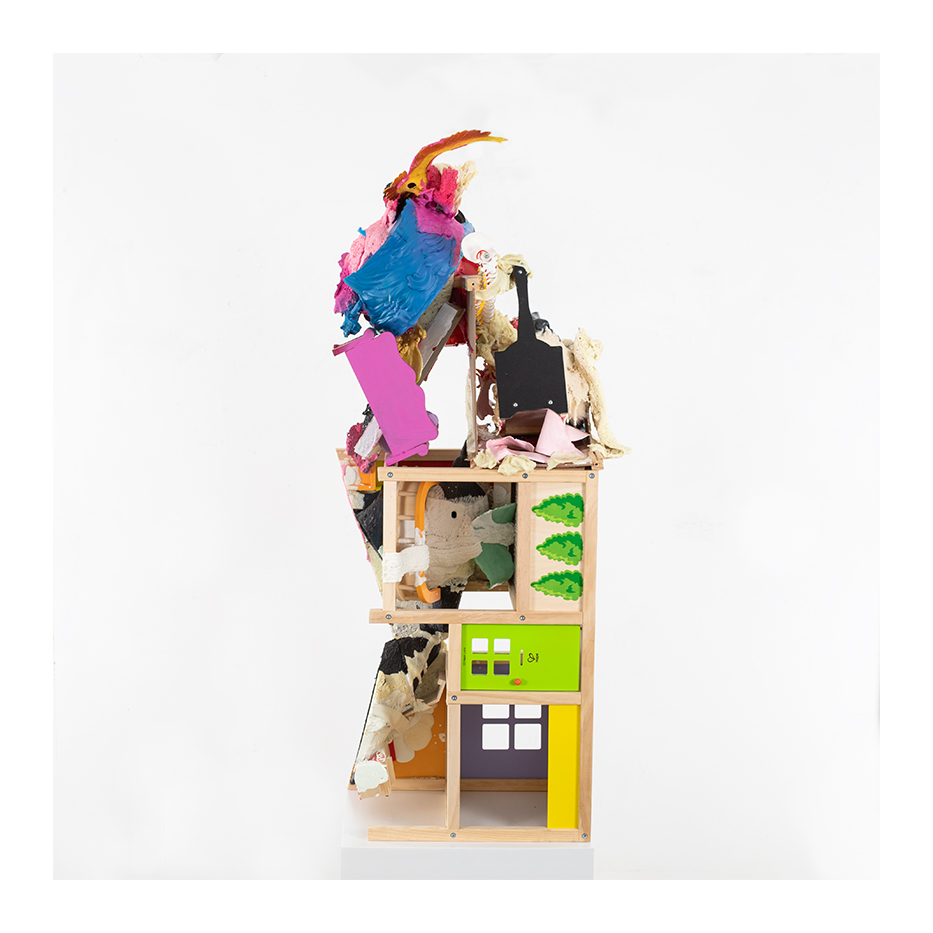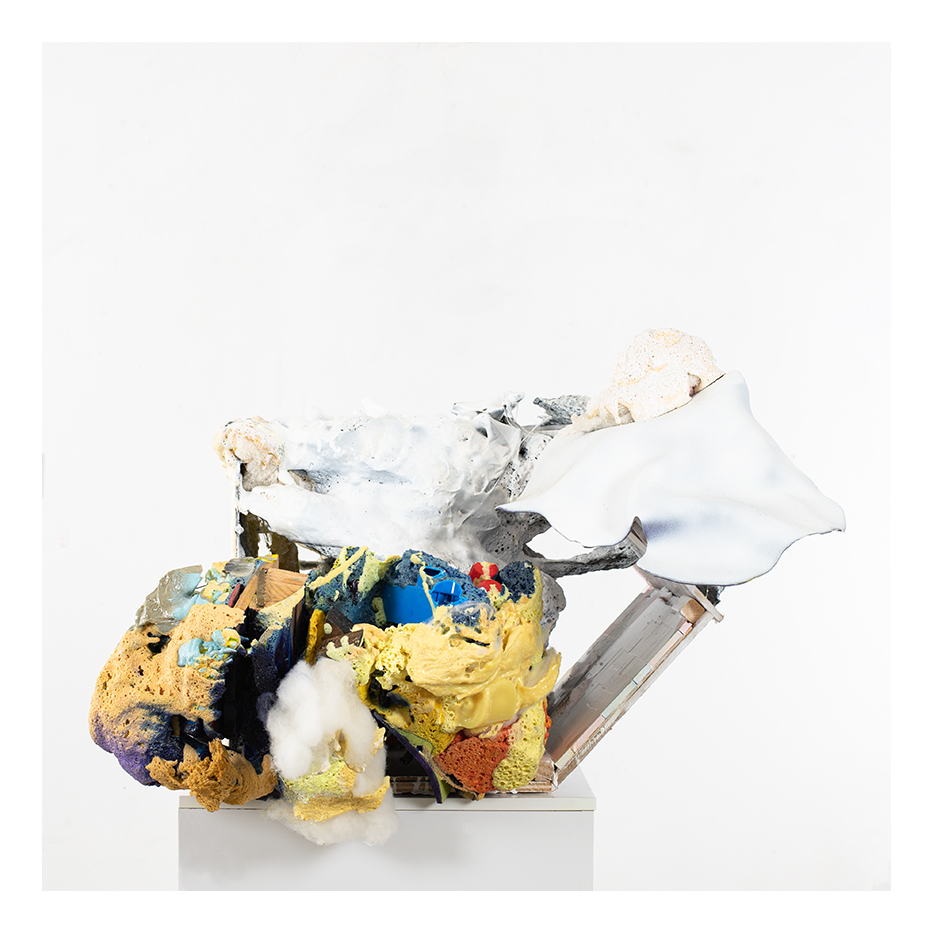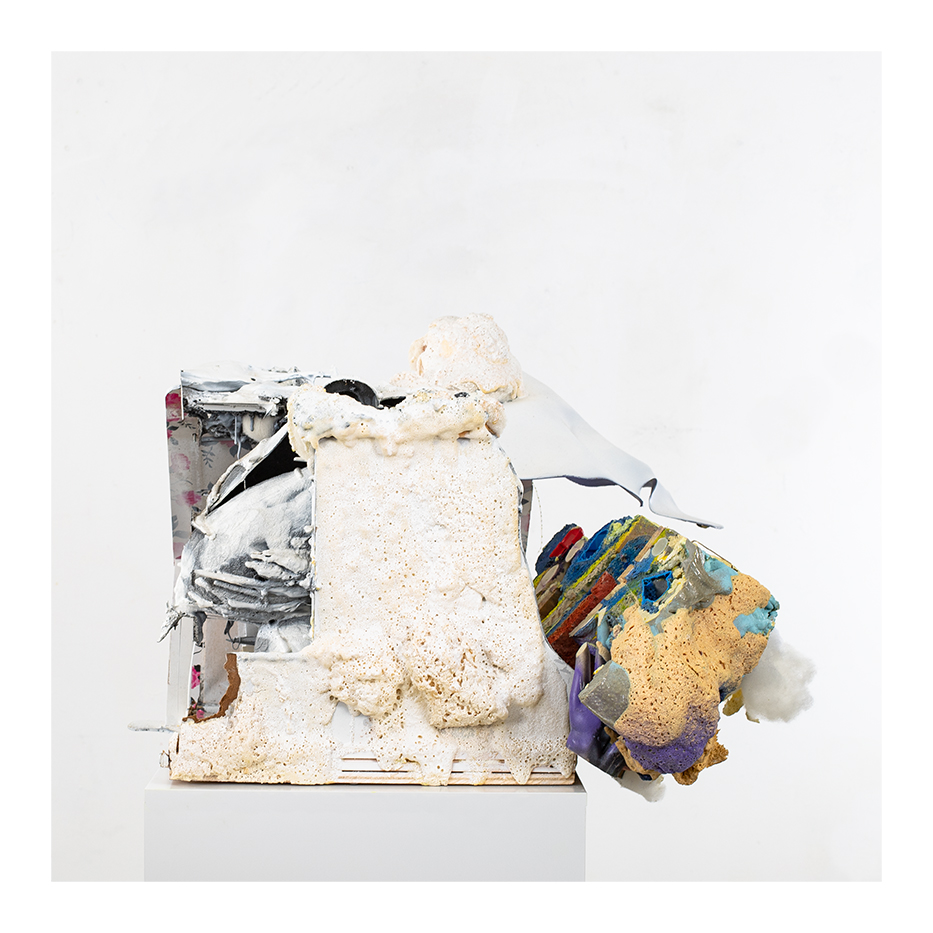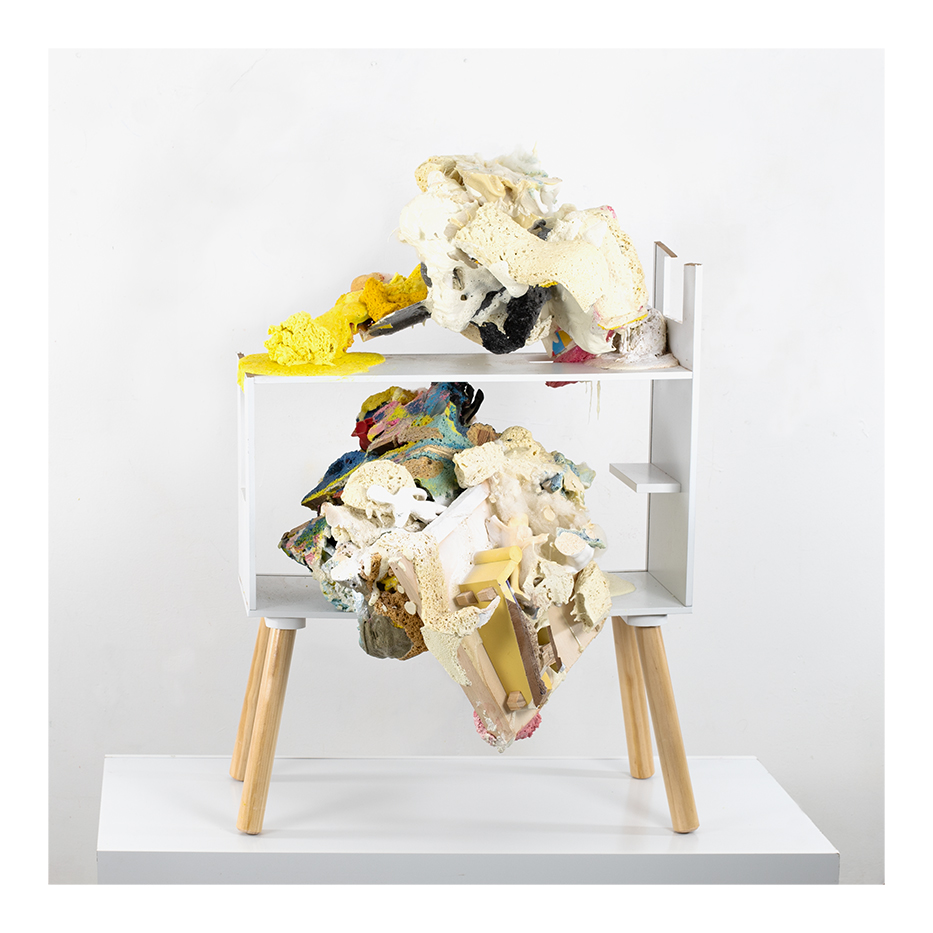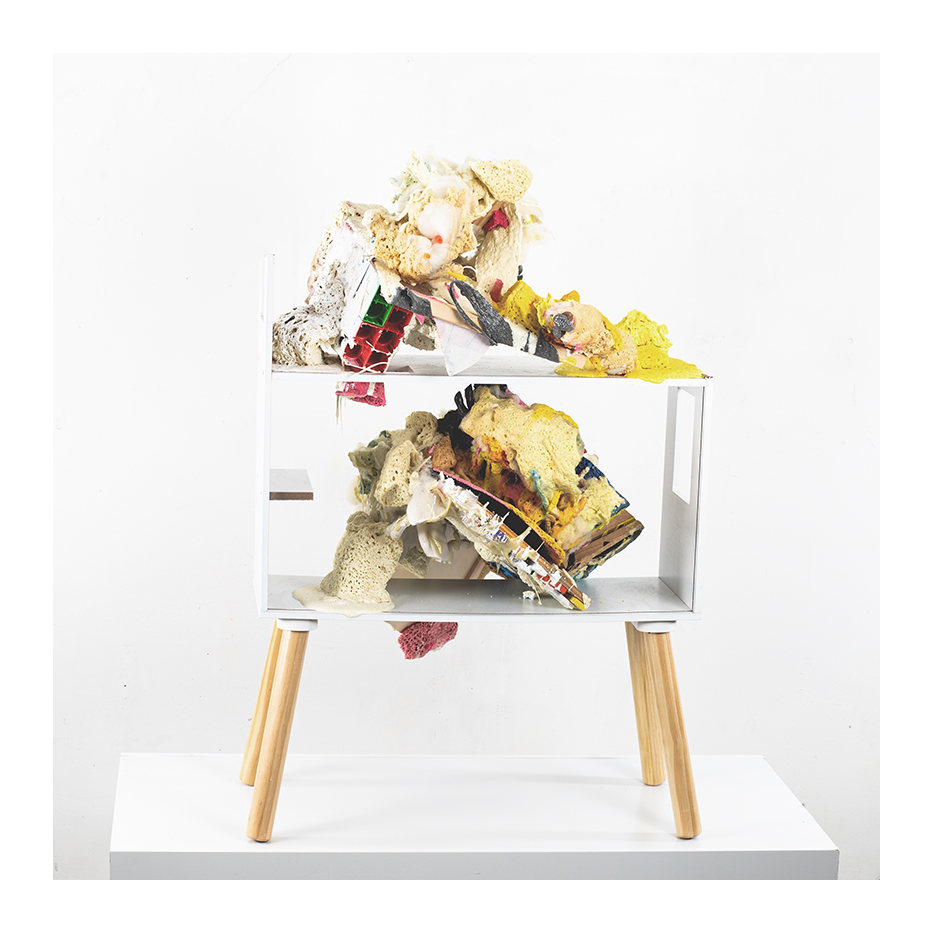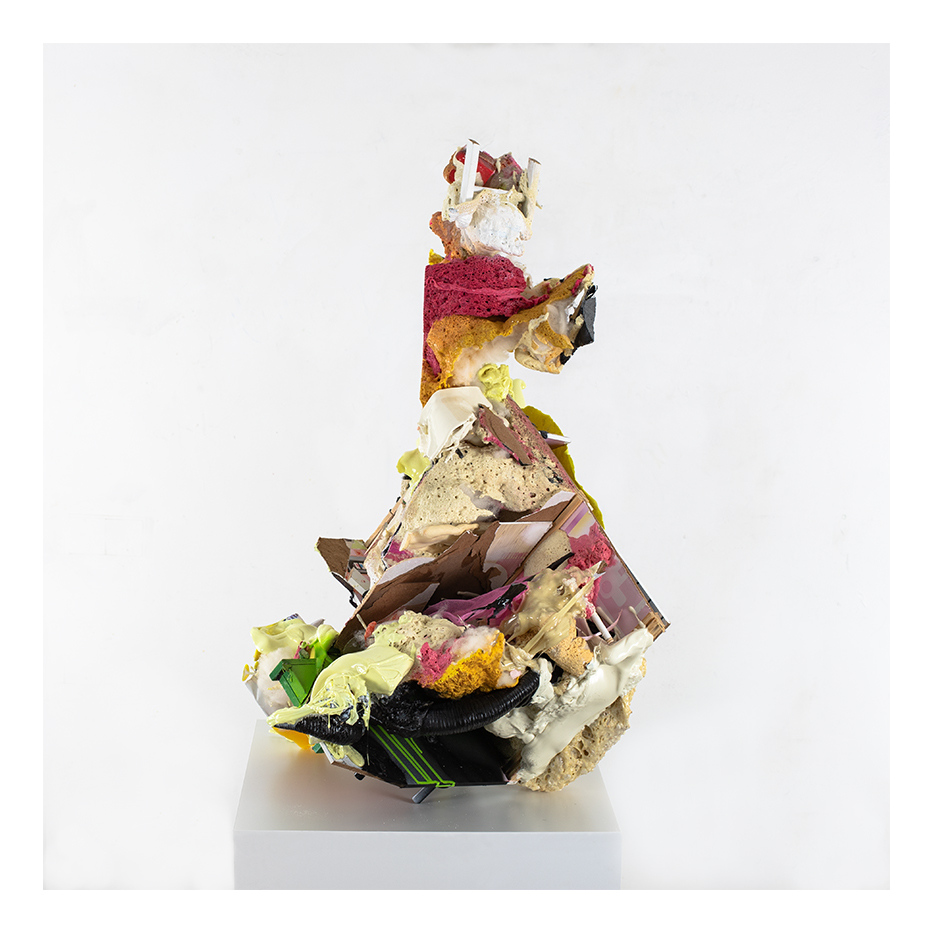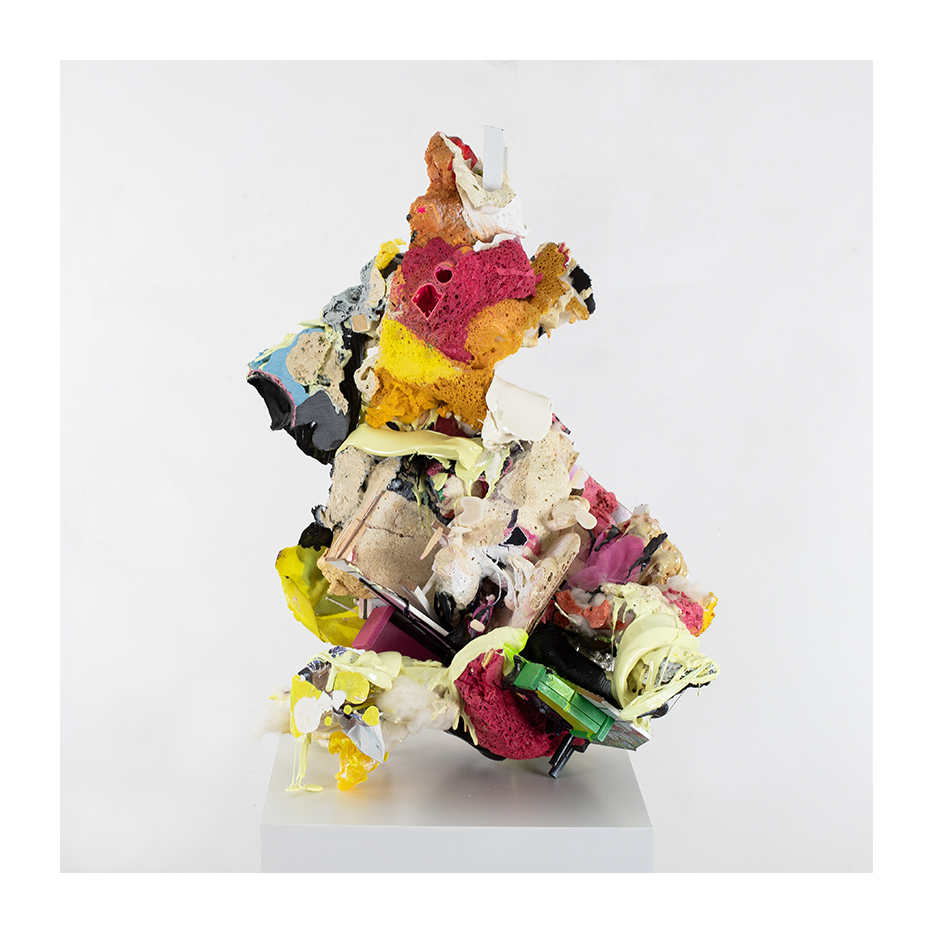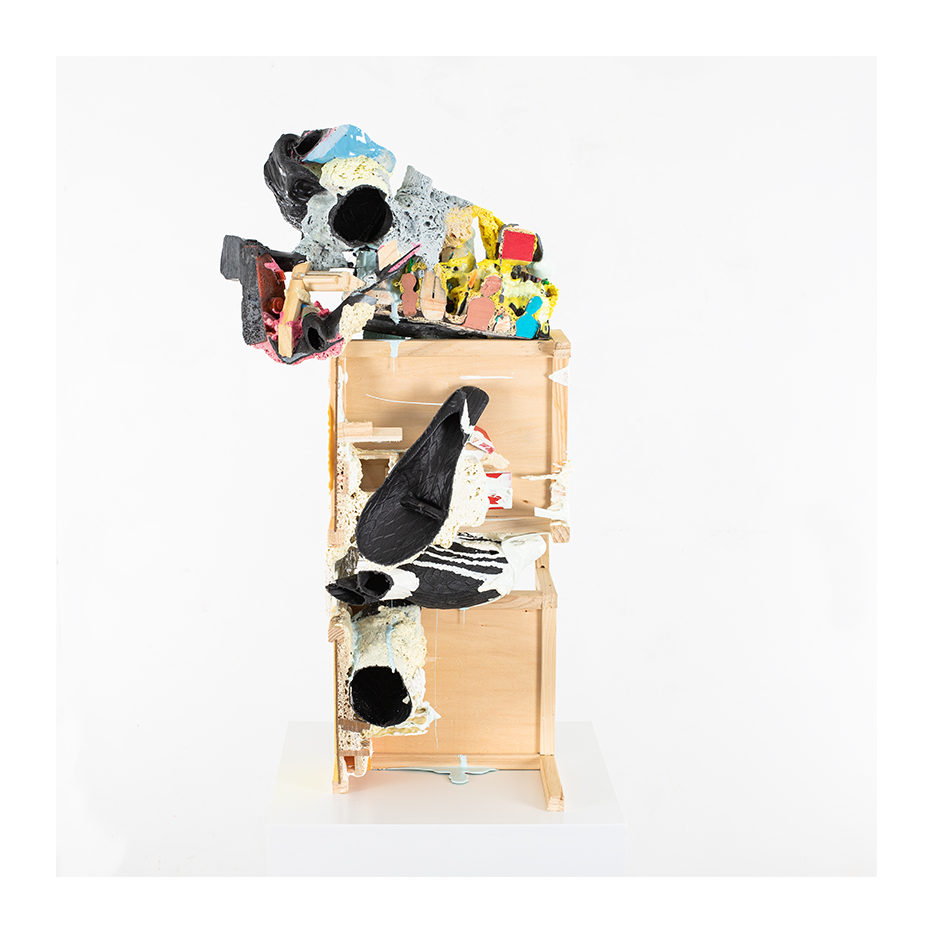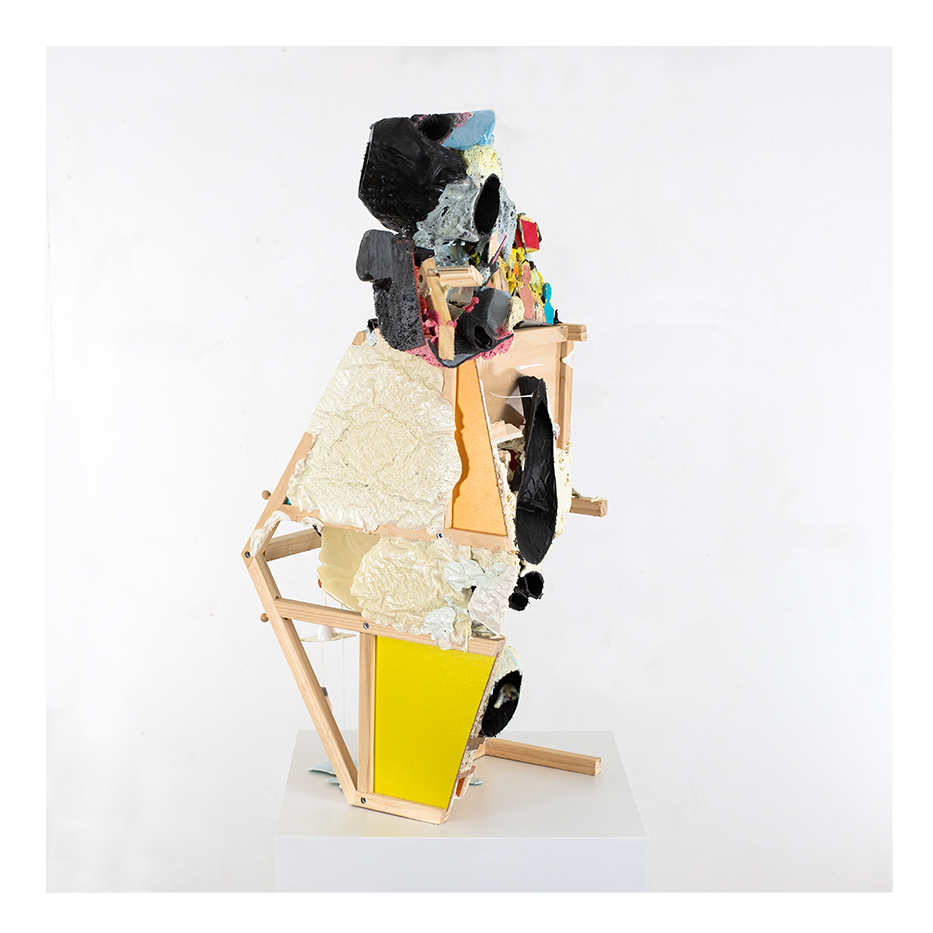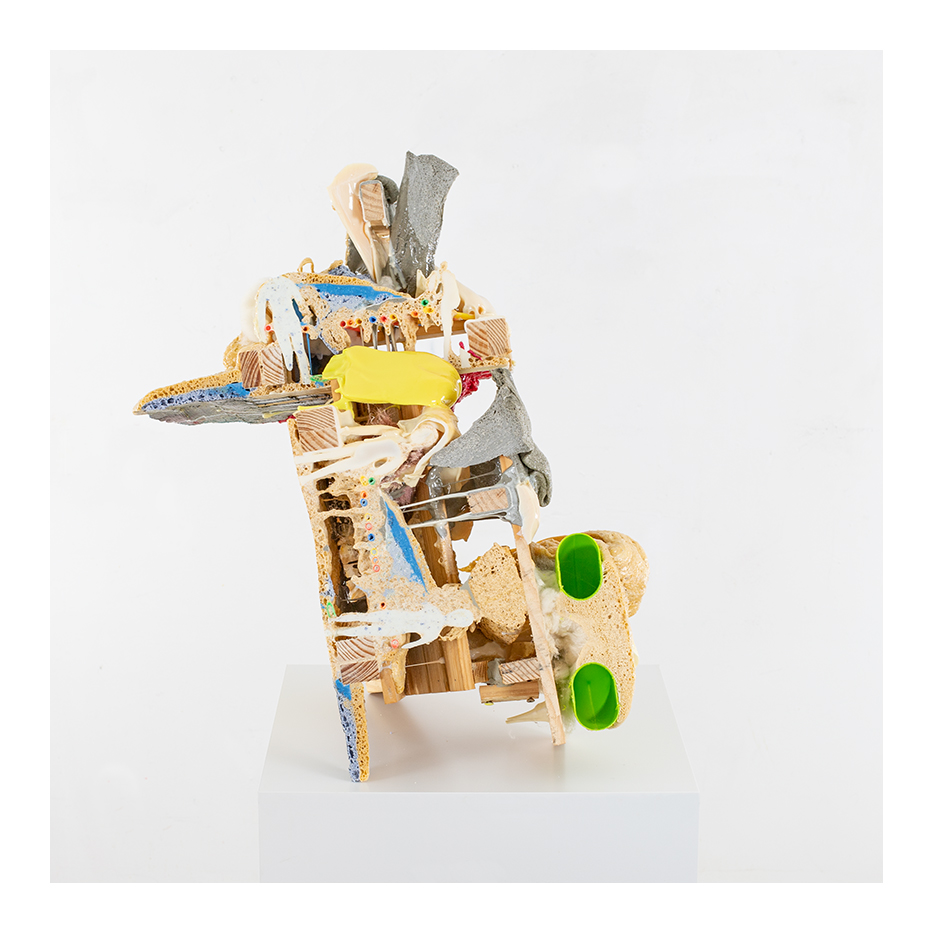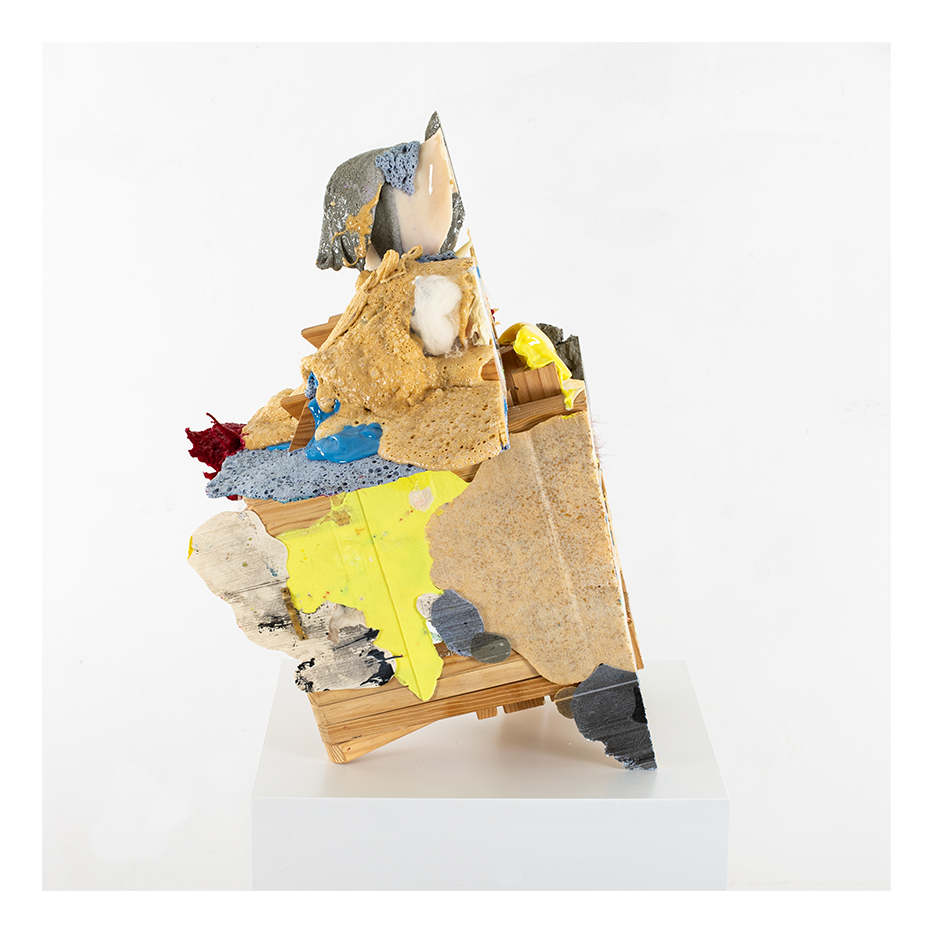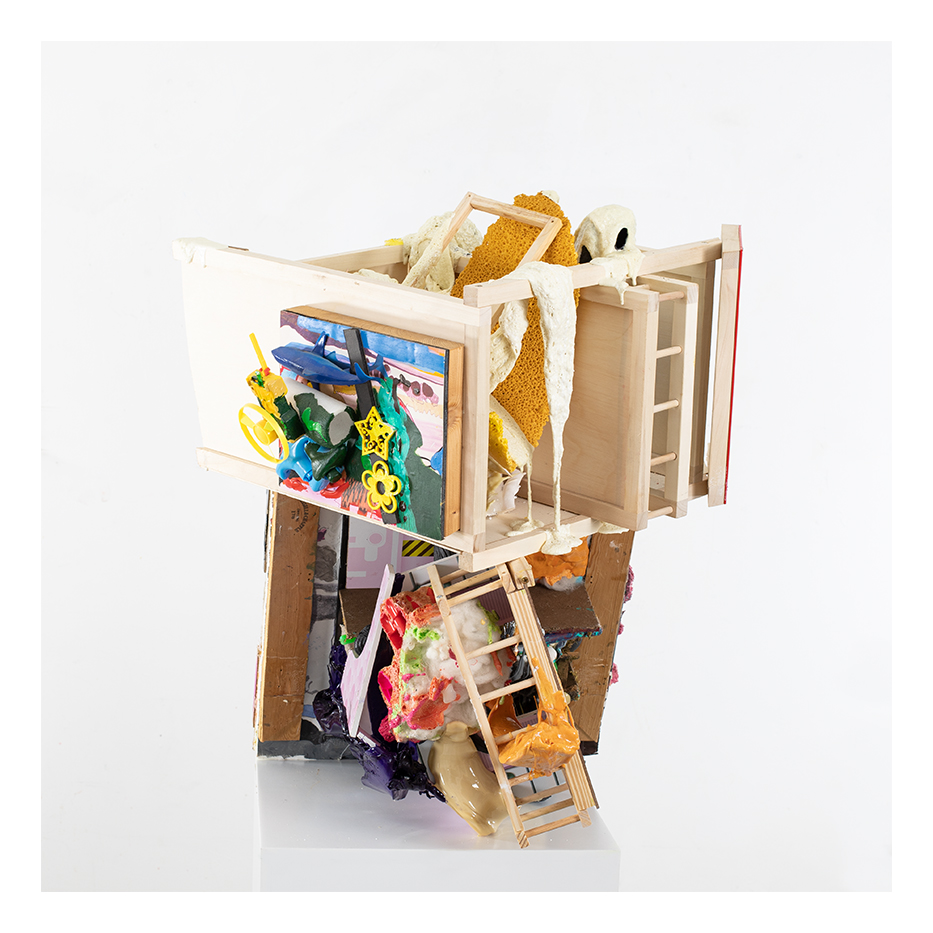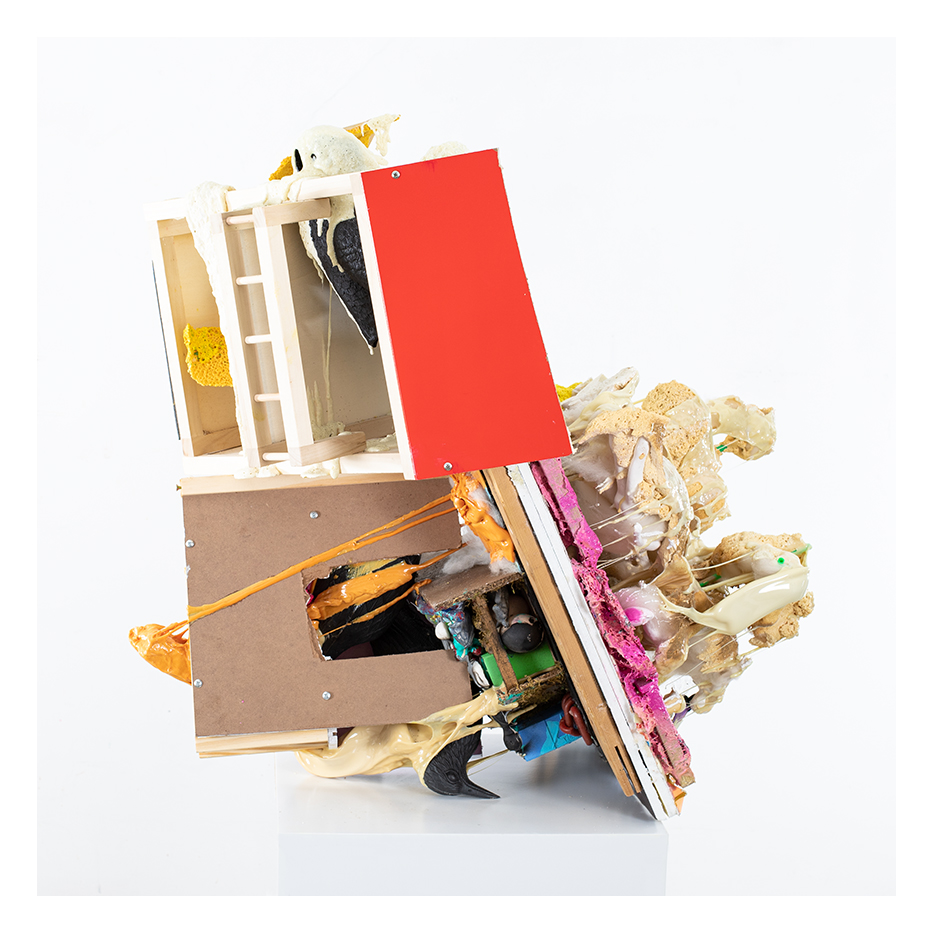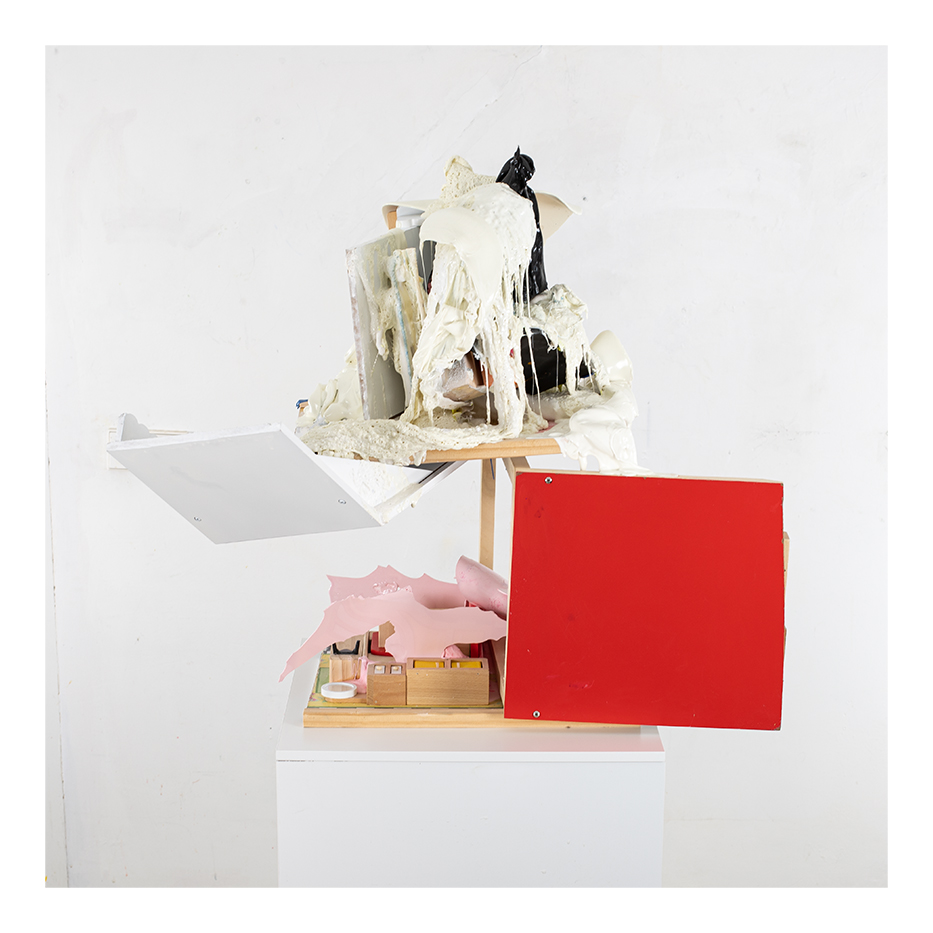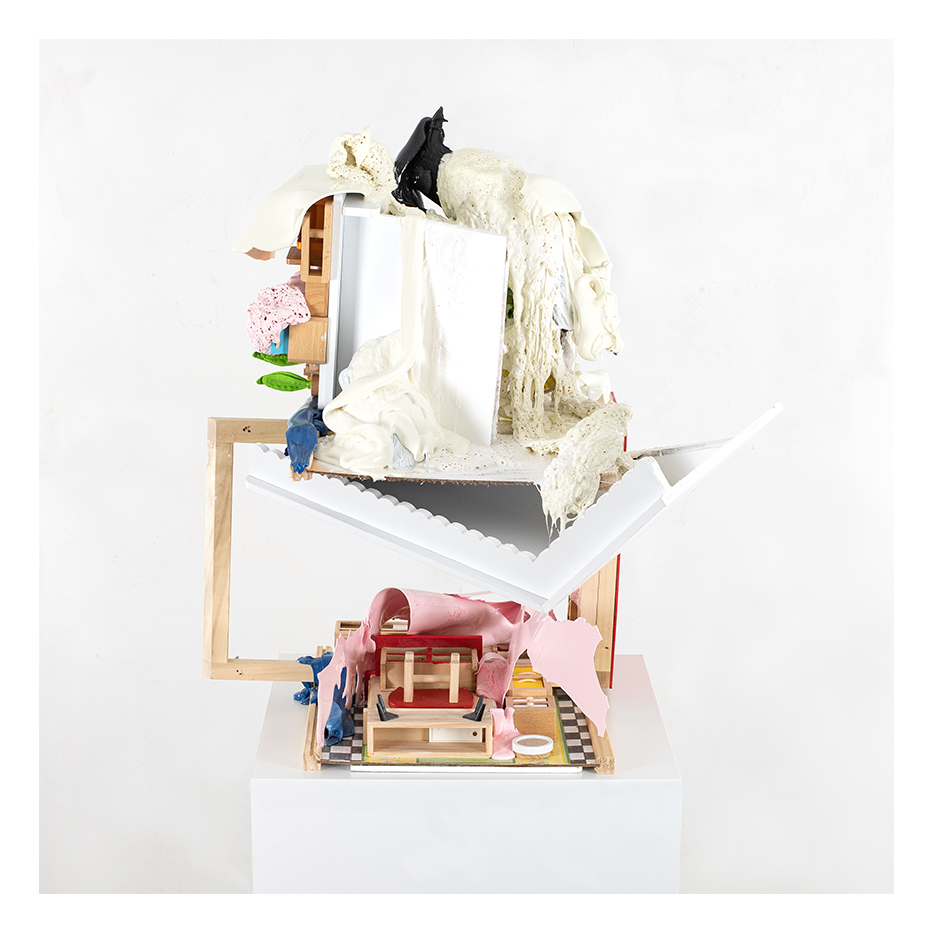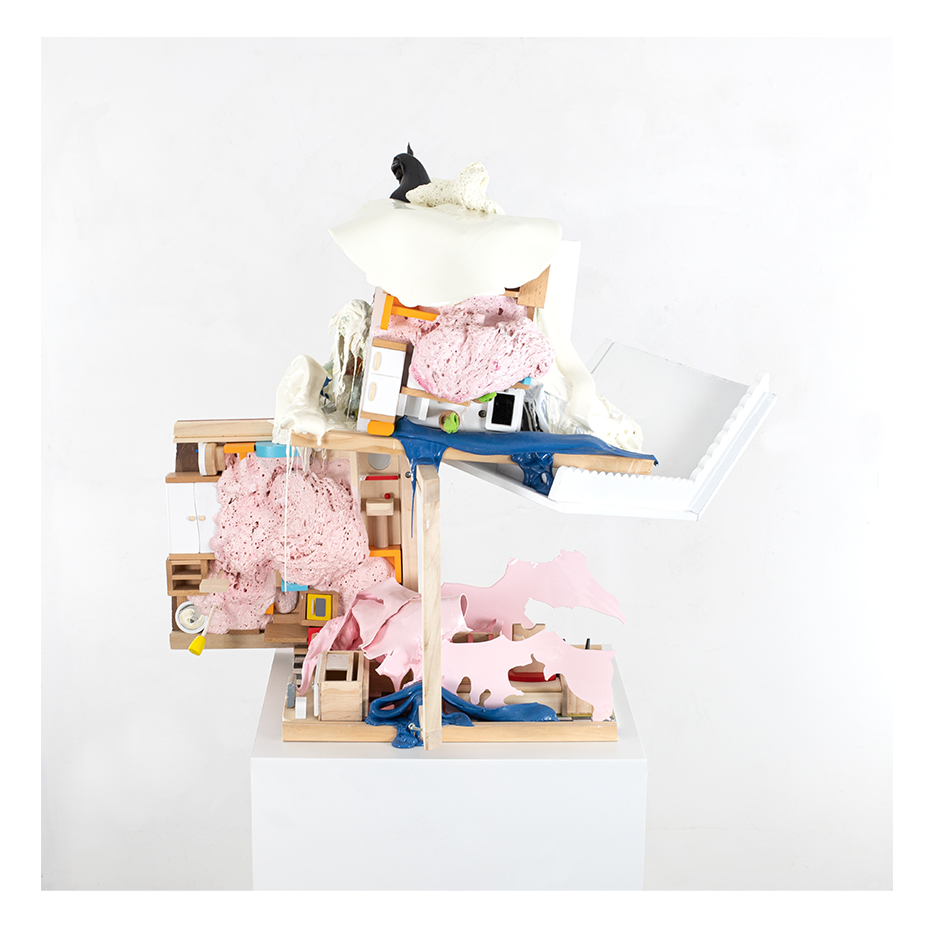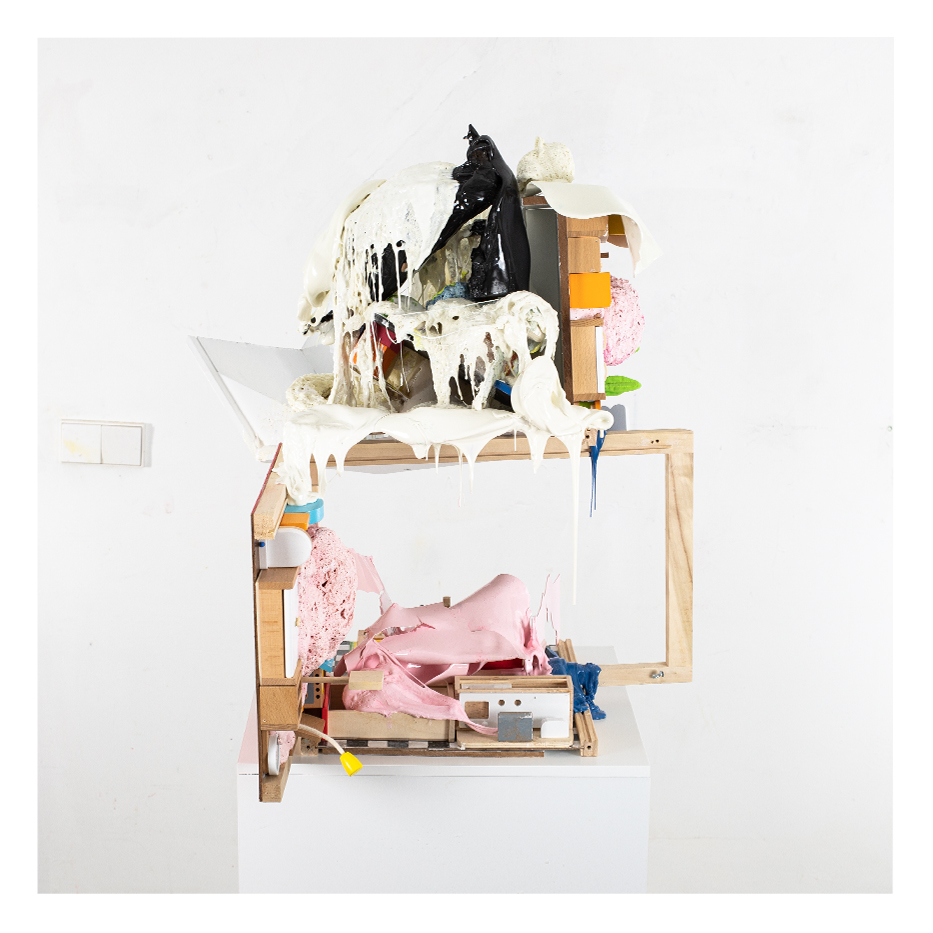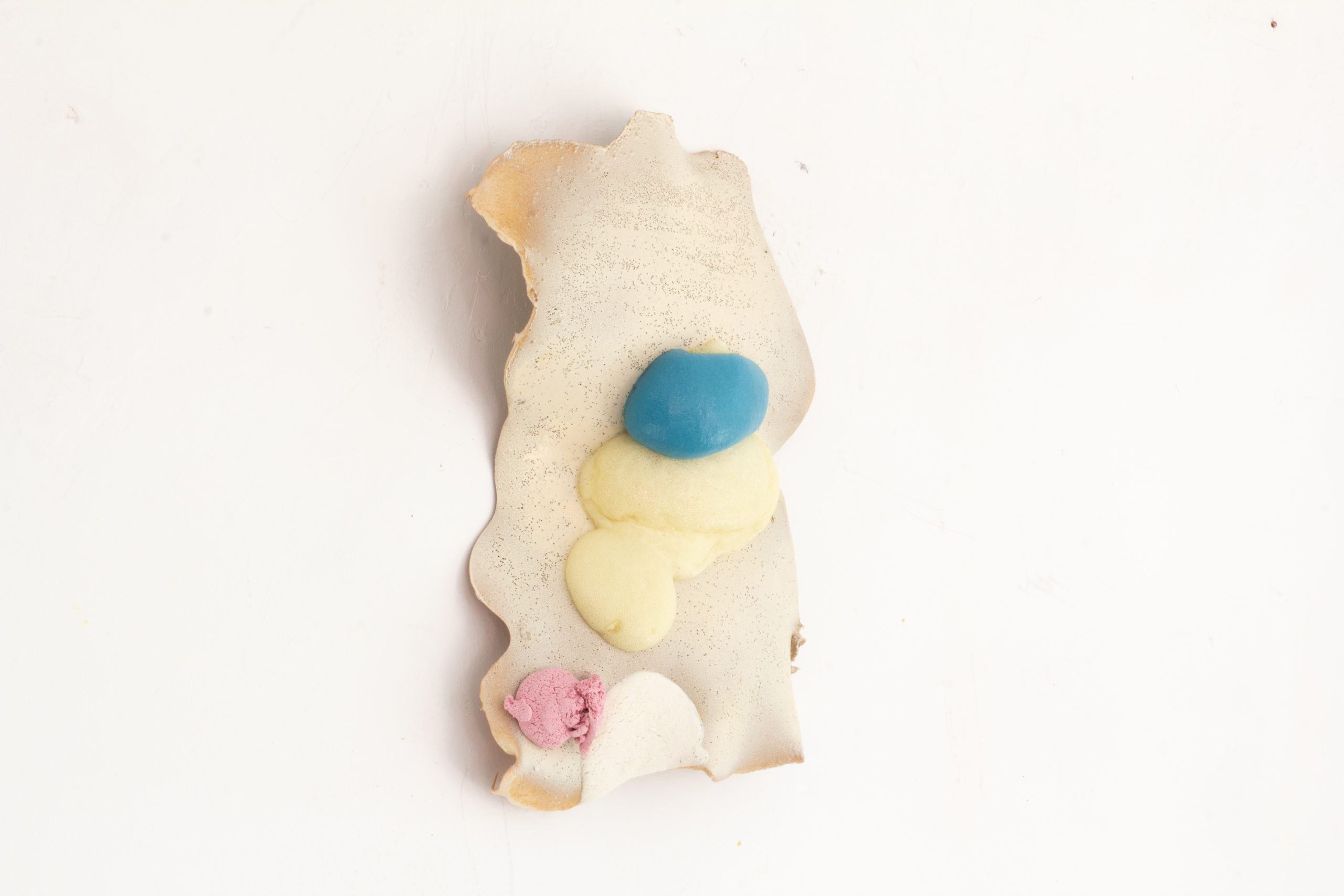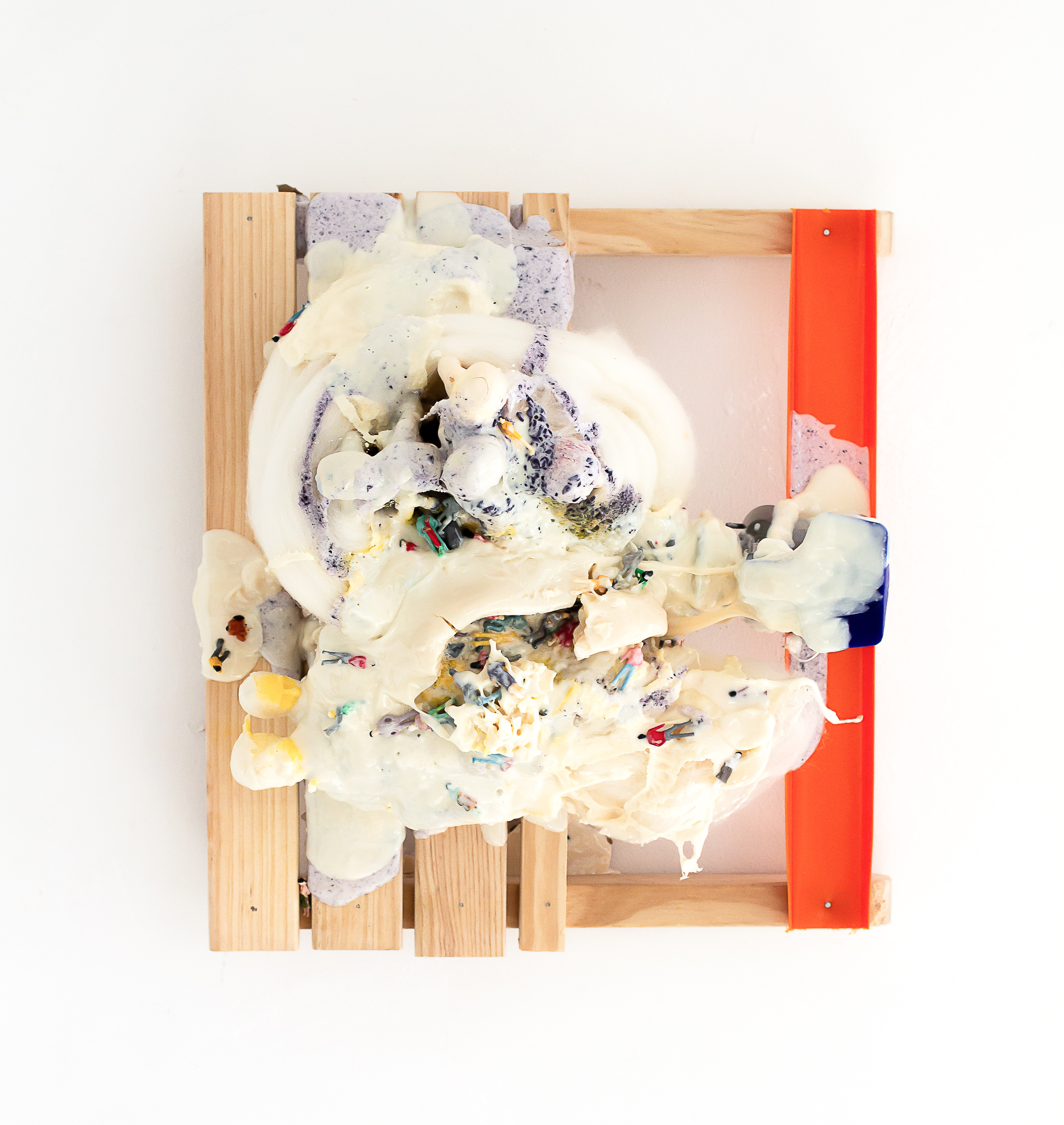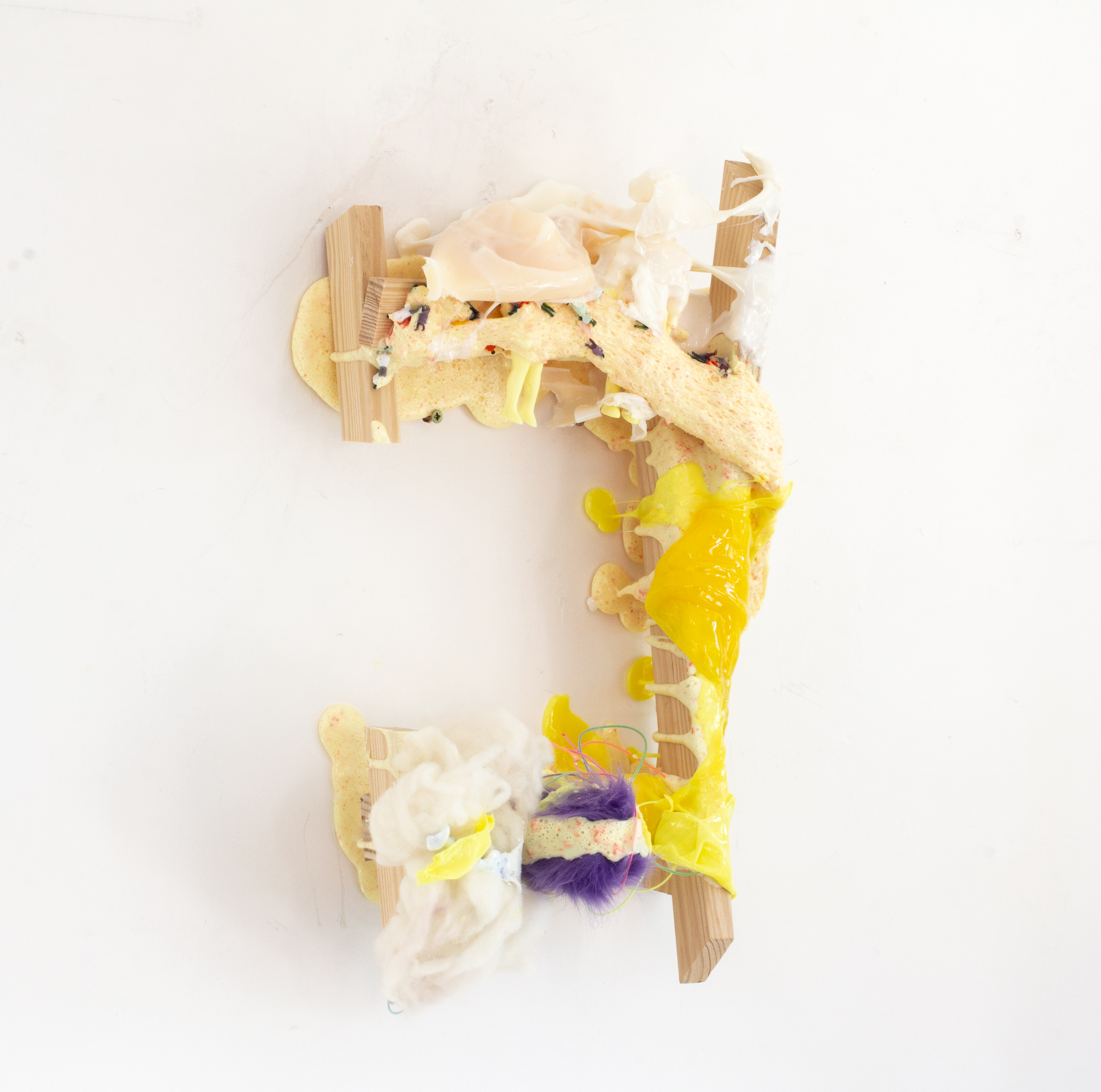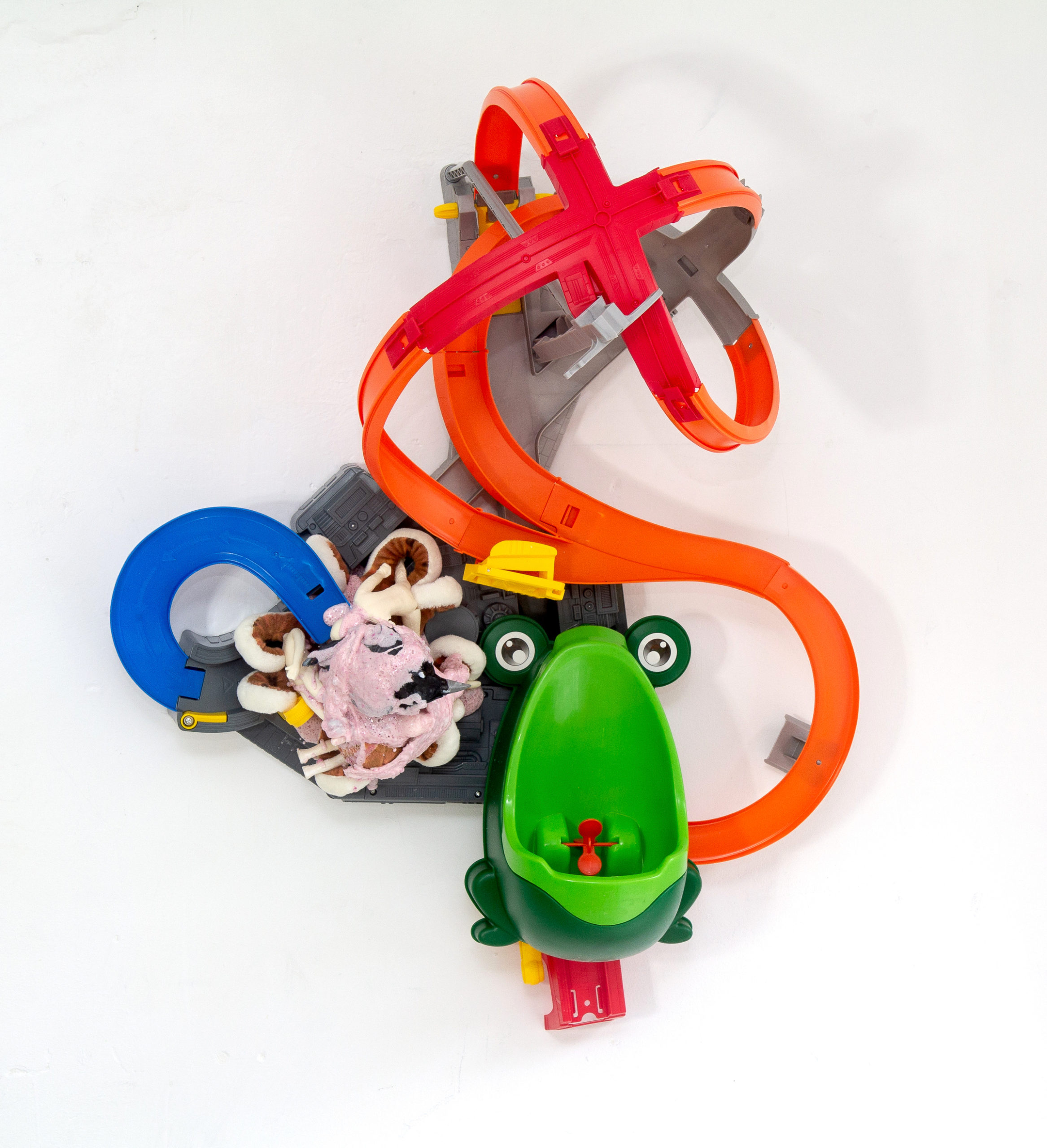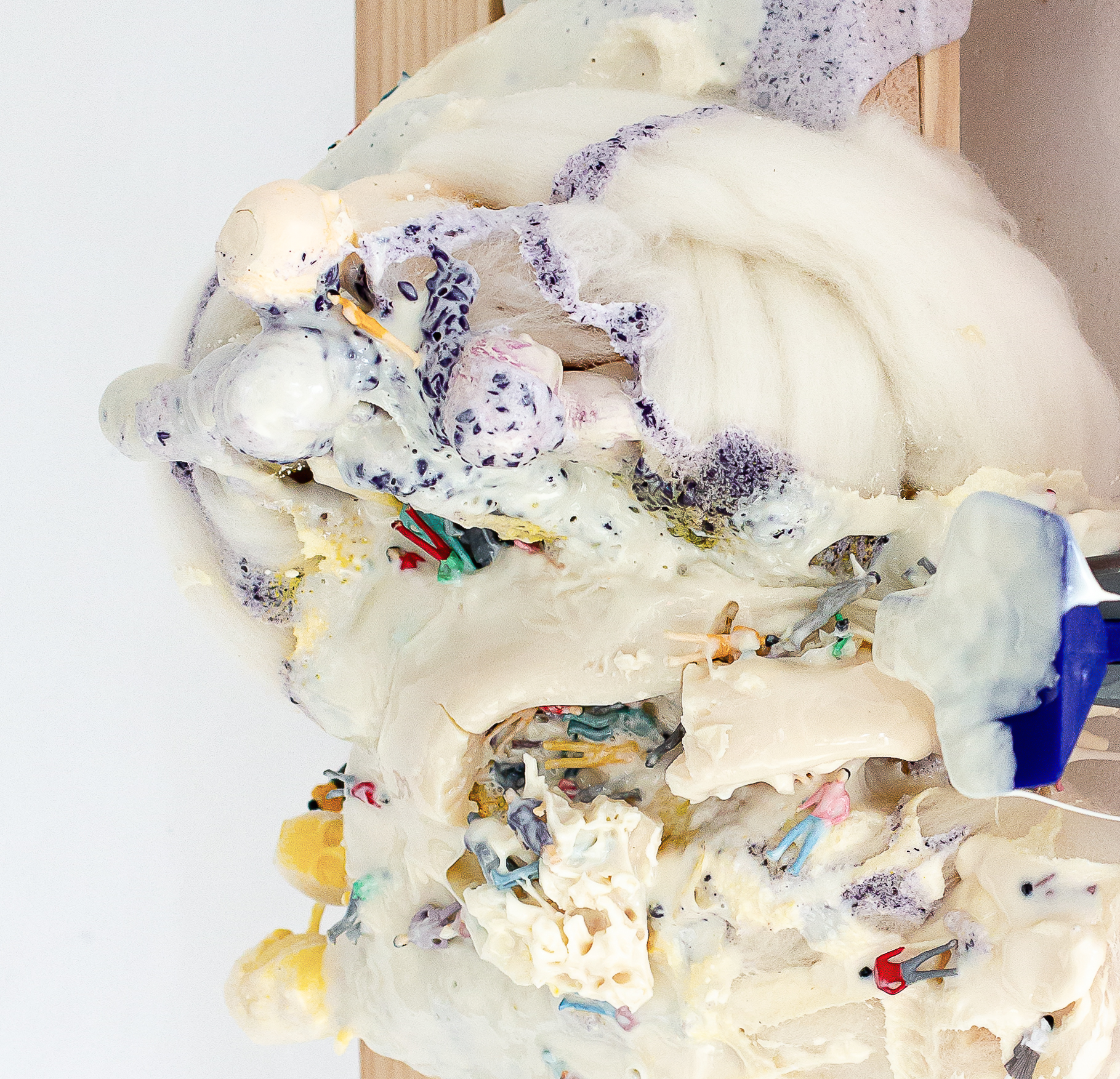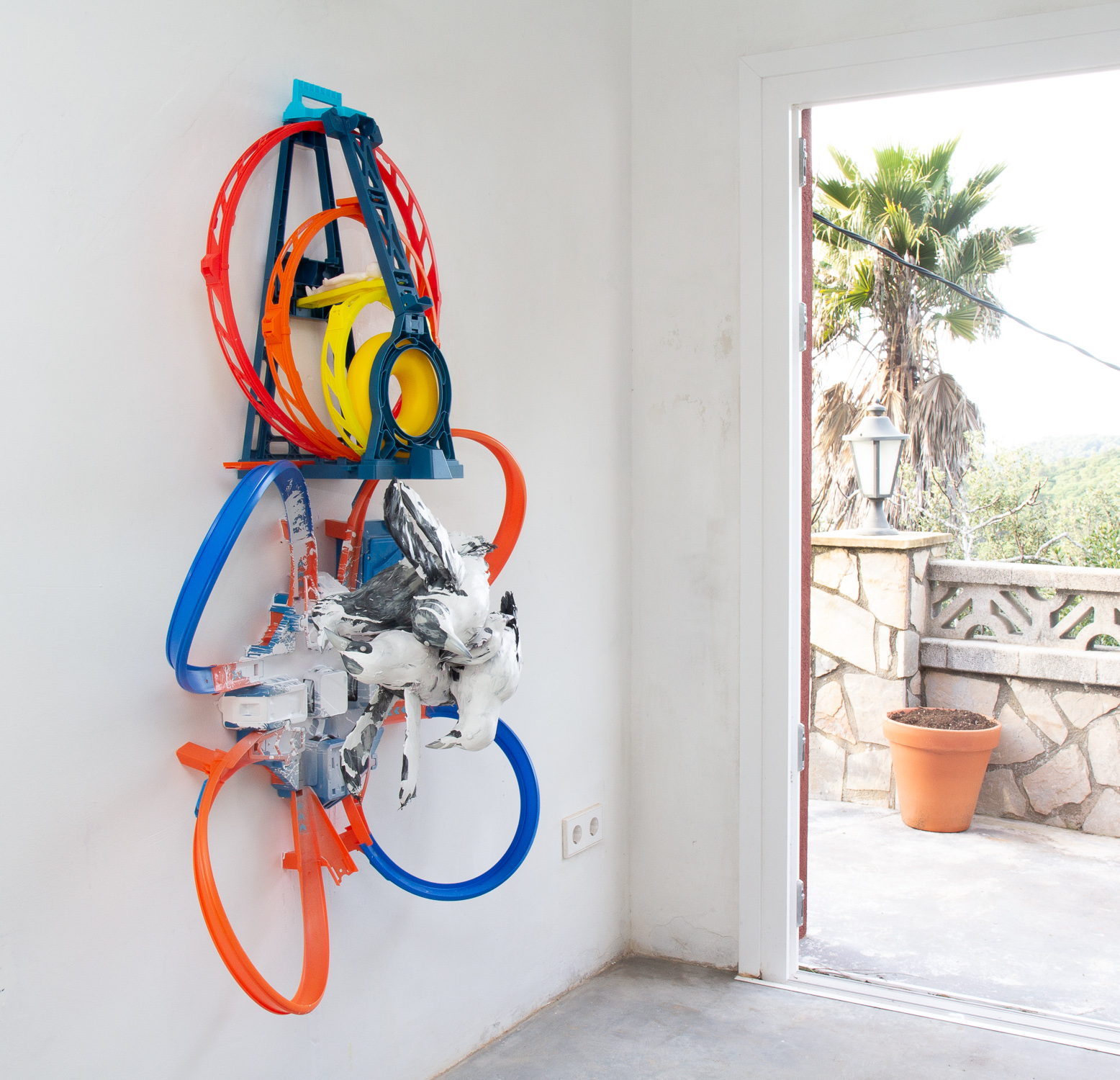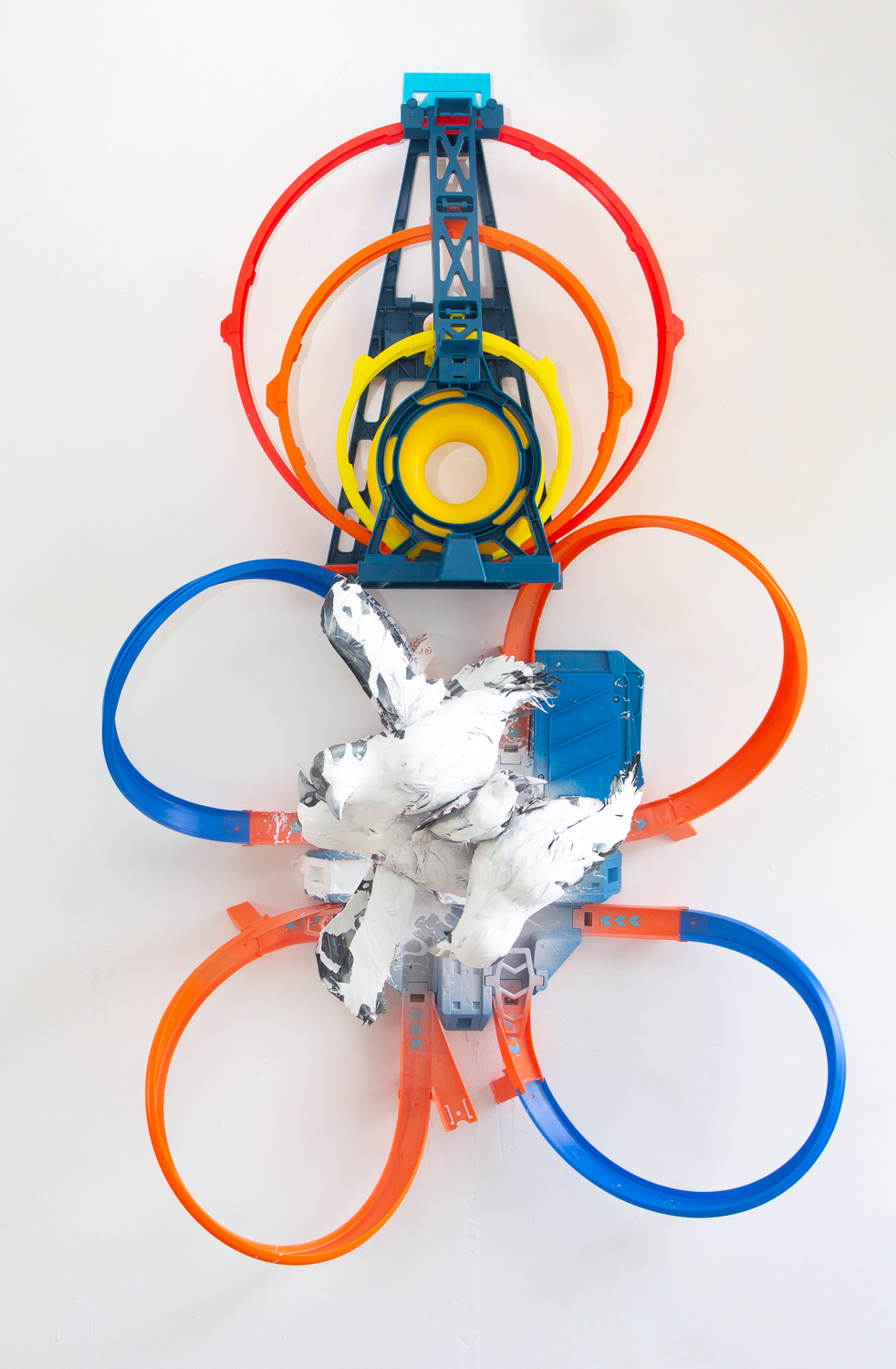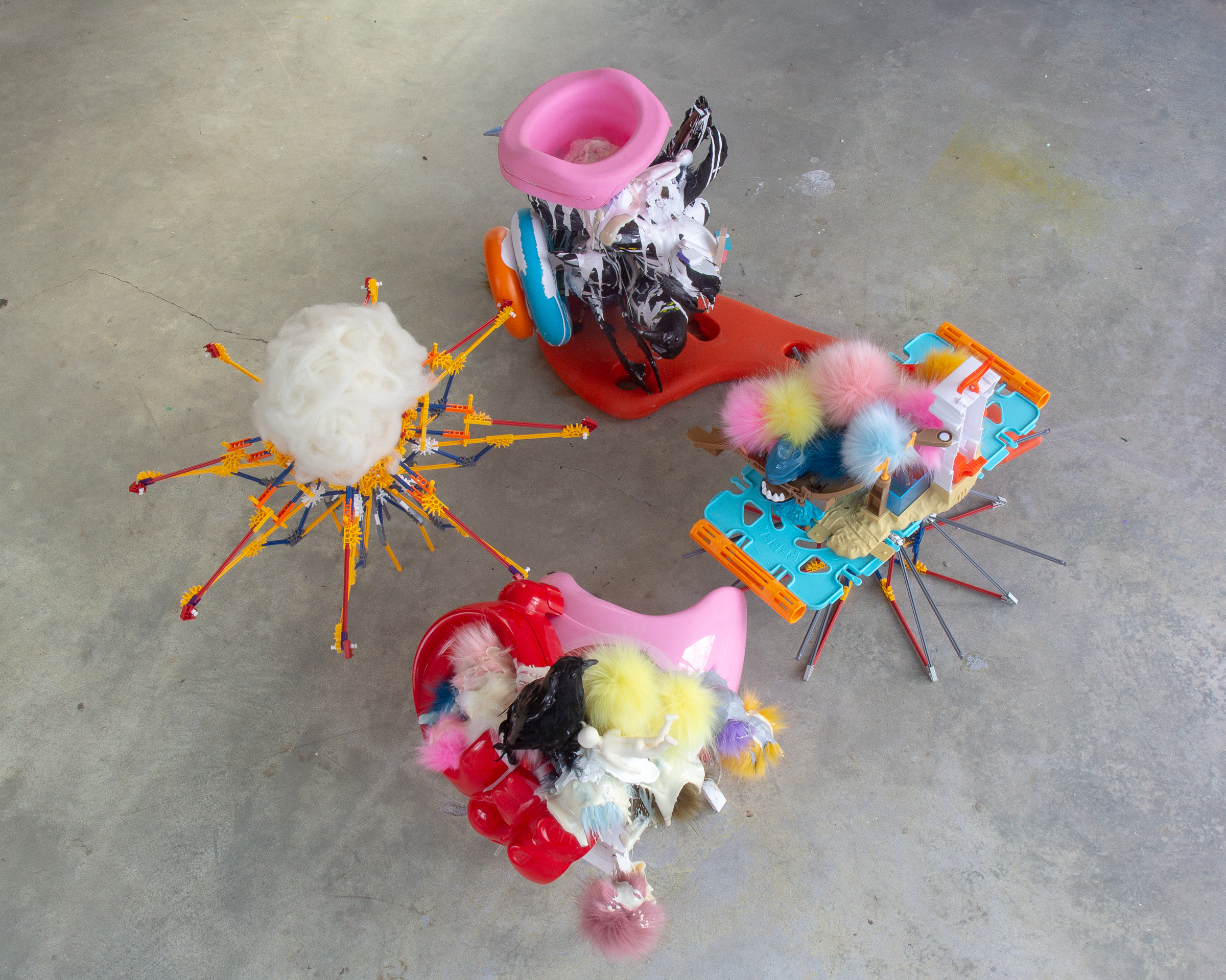Thumbnails of work. The most recent are shown first. Click on the thumbnail to see a larger image in a new tab. Extracts from notes from 2020 (in a stream of consciousness way) as I began making art again are found at the foot of this page. I haven’t written anything in the past two years.
Notes about the work
Not all the work I comment on below still exists in the same form but I hope the words help, they are un edited, just as they were written.
Another acknowledgment of Robert Smithson’s Asphalt Rundown from the 1960s. Also there are large black birds inside. Children’s toys are a frame for abandoning myself to material. Playfully out of control – but worryingly confined in control. It is more disturbing in the real. This brand new thing feels both ugly and beautiful right now.
Take a look at the other side to get the geology idea! I wanted to try to break open the object. I have been filming inside my art with a borescope, so why not actually open the objects up? All made with urethane, acrylic paint, toys, wood and fabric.
Horse started as a toddler’s yellow plastic rocking horse. Then comes skins of colour – mostly wafer thin pours of PU. The internal space is drawn out by chunky lego-style blocks and rods of polyester. The figures, there are two, were made in a silicone mould. This piece is really tricky to photograph. The flat screen image seems nothing compared to the torso-like curvey presence of the piece, which projects over half a meter from the wall.
I love the way paint dries to form a skin. Here, skins pull and peel away from the base (already an injected ‘skin’ of plastic popped from a mould). As an art student, I so admired the push/pull of Hans Hoffman. He battled with surface layers using colour and gesture (often including regular shapes) to create an illusion of colour space that was, of course, simultaneously flat – a skin!
There is a tension in me between the abstraction and the inclusion of human figures. I want to make a kind of ‘Gates of Hell’. I am nowhere near even knowing how to start, but maybe there is a kind of post-apocalyptic mad playfulness about this, as a couple of human forms free-fall in joyful plastic constructed onto a children’s rocking horse.
Each face of the smaller octagons is a fragment of English artist Christopher Wood’s painting Zebra and Parachute (1930). The tiny figure that dangles in the parachute harness appears limp and lifeless. The Tate Gallery confirms that this was one of Wood’s last paintings. A few months after making this, he threw himself under a train at Salisbury station. He was 29 years old. The larger octogens are fragments of my own ‘Book of Sand’ assemblage finished a couple of months ago as an echo of Borges’ story about a book of infinite pages that can be owned by one person and held in the hand. A pink butterfly appeared in work I have been making with children’s stories in mind. Here, this is an image of images of images of art, all fractured into facets of mathematical solid forms. They are set onto a base of abstract painting. Now it is on a wall and swimming in polyurethane pours and white men falling. It all feels very sad.
There’s a tremendous and inspiring sequence of photographs in the book, ‘Formless, A Users Guide’ documenting Robert Smithson’s Asphalt Rundown from 1969. A tipper truck is delivering a pour of liquid black asphalt down the side of a quarry. Amongst many references, there is the crystallisation of gravity affected base liquid as time lets it cool and solidify. This piece is tiny in comparison, but partly inspired by the pouring and spooning of resin and paint into and onto a solid structure. The 1950s, 60s and 70s still have a lot to teach me. I want to let emotion free. Hence the gestures, the actions, but emotion needs something to hold it. I’ve been listening to Sibelius’ symphonies whilst making this. IMHO a masterful example of just that! Ha 🙂
Grief is the thing with feathers. Max Porter. What a book! This is no illustration but maybe a homage. I can only dream of making art like Porter writes. There is no doubt that his emotional power and precision saturated my psyche whilst making this.
I was listening to Huxley’s Brave New World making these. As I explored cloned peopl, children’s play items andHot Wheels kids kits, I thought the dystopian/utopian drug was a fun title!
A friend commented: “Our somatic lives I feel have – as here – been turned a bit upside down with all this brave new zooming about the world. Experiencing hyperstasis and hyperconnectivity all at once. And the ups and downs of it all are just perfect here”.
Hot wheels is made from a kit of parts from a children’s toy designed for 5 to 8 year olds. It seems to live somewhere between painting and sculpture. Also, somewhere between the world of children’s toys and the contemporary art world!
‘I was a child’ is modular. There are smaller, almost self contained, passages the are appended and interlinked in the one piece. There are echoes and resonances of other art (from my own recent work and well as other artists). The piece is freestanding and double-sided. Playfulness takes centre stage. Young children generate new ideas and experiences as they play. Play is the engine of learning and creativity. Play stimulates children’s developing and meaningful communication. I suggest this is a vital quality when making art. In this work there is an ambulance in the two and three dimensional image making. There is a reverse side (below) and a second free standing version of Side 1 with the ‘Book of Sand’ work (see below). There are details to finish on that and the top wood bar is temporary.
Two Birds for Jasper brings together the two most recent works from the summer SVA residency into one. I’m finding the way the echoes and resonances as the objects attach and detach themselves from each other is really feeding me. Here, the references to my father’s hallucinatory visions of large birds as he was dying is combined with a playful piece partly inspired by the assemblages Jasper Johns saw making in the mid 1960s. There are quotations from my own work and from drawings made in the years following my father’s death. It is probably autobiographical in content but simuteneously playfully avoiding deeper truths. Maybe. I am becoming really engaged with the work of contemporary artists: Jessica Stockholder, Judy Pfaff and Gabriel Rico to mention just three. ‘Two Birds for Jasper’ is bitter sweet. There are many smaller references inside the work as, for example, in the top piece quotations from recent art are folded into 3D mathematical forms.
This was to be called ‘Do not go gentle into that good night’, the title of the Welsh poet Dylan Thomas’s probably most famous poem. It concerns death and in particular the death of his father. I loved Thomas’s poems as a teenager. There is an emotional backdrop about my father’s death that surfaced whilst making this piece over a couple of days. Memory recall rather than illustration of the past. This is, as well, is a response to critiques from the SVA Residency in Week 2, including: move away fixing a back plane to the wall; break the rectangle and invade surrounding space; make sculptural forms that inhabit the hinterland of painting; try and be more emotionally specific with form and colour relations where that supports the particularity of feeling; consider work from plethora of recommended contemporary artists. This one is hugely influenced by Jessica Stockholder’s studio pieces!
To Fall (18 x 41 x 14cm) contains image quotations from 3 recent assemblages of mine (Book of Sand, Maskenball der Käfer and Tyranny). Each quote is folded into a tetrahedron or octahedron and set in references to abstract oil painting from the last century and also within a drawing from last week (which has also been folded into mathematical solid forms). Here I am, maybe and as it were, free-falling through images of my own art from the highest ragged Mediterranean cliff to the sea. I wanted to find grip in structure to hold overwhelmingness but inevitably fail.
Tyranny is made from: 1) the graphics from the boxes of plastic replica model kits of a Hienkel 51B-1 biplane used by the Spanish airforce during the civil war; 2) blocks of dragged oil paint on canvass referencing abstract painting from the 1980s; 3) my own recent drawings folded into 3D mathematical forms; 4) acrylic paint; 5) wood and foam board. The title is ‘Tyranny’. That partly refers to the twin tyrannies of narrative and image. Both can denude experience. I personally find it hard to escape those tyrannies when making and sharing art objects! This is now reworked and part of a new piece.
When making this, I was been reading Borges’ short story ‘The Book of Sand’. This is a book of infinite pages, which is nevertheless a definitive volume that can be hidden in a library of a hundred thousand other books. One paradox is that you can hold infinity in your hands. But this inescapable truth is unsettling, frightening and even monstrous. In parallel, a painting is a frame for infinite possibilities, which, nevertheless, might be completed as an aesthetic whole to be sensed in an Instagram glance. That illusion could easily become disquieting and not very real. This has now been reworked into a new piece.
I made a companion piece for ‘Soledad’. The work on the right above is called ‘La Casa’. I stepped away from the Buendía family as I had become a bit obsessed. But the Marquez story has also sent me back to abstract painting I was making 40 years ago. I should acknowledge and revisit the past.
Soledad (40 x 40 x 20cm) As I finished reading Hundred Years of Solitude, the small decisions as I was making in this piece seemed soaked in parallel emotions. I am not sure how that works? This is not an illustration and there are no deliberate attempts at equivalent imagery. But if I keep this, it will absolutely remind me of this moment in my own history and Marquez’s final chapters
I loved the work of Welsh poet Dylan Thomas as a teenager. The title of this is a line from ‘Poem on his Birthday’ begun as a self-celebration of Thomas’s own 35th. The piece is not illustrative, rather it evokes echoes of older emotion: ‘And the sea that hides his secret selves’ as Thomas put it later in the poem. I was also reading and listening to the first four chapters of 100 Days of Solitude again when making this. Again, no attempt at illustration. More like nostalgia. Is a hybrid magical realism rubbing off? Looking back or forward? Hard to tell!
I began Nativity before Christmas 2019 after buying a nativity scene in Palafrugell, the Catalan town close by. I worked on this for about three months. It was the first work to be finished after the Spanish declared a State of Emergency and we entered a extremely severe ‘lock down’.
